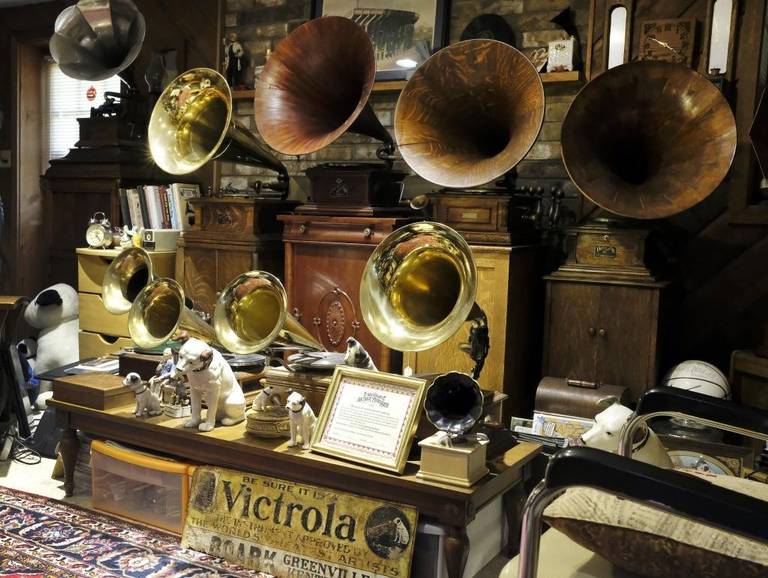Brian Gorrell spent most of his career teaching music to children, including directing the Henry Clay High School Band in the 1970s. But for the past two decades, he has sold, repaired and collected their ancestors’ mechanical music machines.

The basement and garage of Gorrell’s home in Lexington is filled with about 200 acoustic phonographs dating from the 1890s through the 1920s. He also has a nickelodeon, a roller organ and other pre-phonograph music boxes.
Almost all of these machines work, and their discs, cylinders, rolls and cobs fill the place with songs from a century ago, when jazz was new and the vinyl album, compact disc and mp3 file were futuristic fantasies.
“These get a bad rap,” he said. “People say they sound scratchy, but if you get a good, clean record and a new needle, it makes a world of difference.”
I discovered Gorrell at the Athens Schoolhouse Antique Mall’s monthly show, where he was holding forth with customers. He also sells at the Meadowthorpe Antique Mall.
“The part I enjoy is educating people,” said Gorrell, founder and president of the Kentucky Antique Phonograph Society, whose 15 or so members meet monthly.
Surprisingly, he said, most people who buy antique phonographs from him are in their 20s, 30s or 40s.
“Young people are fascinated with these,” he said. “Older people are trying to downsize, so they want to get rid of them, or they want to have one restored for a child or grandchild.”
Gorrell got the collecting bug in 1995, when he bought two early-1900s Edison cylinder phonographs at an auction. As a musician, he was fascinated by the technology that first allowed people to enjoy music anytime, anywhere.
First there were music boxes, then roller organs and multi-instrument nickelodeons. Thomas Edison of light bulb fame invented the first crude phonograph in 1877 using tinfoil. His first recording was a recitation of “Mary Had a Little Lamb.”
Edison’s first commercial phonographs used waxy cylinders to play two-minute and later four-minute recordings. A sapphire or diamond stylus transmitted vibrations to a “reproducer” that sent the music out a horn made of metal or wood.
Its first major competitor came after 1887, when German immigrant Emile Berliner invented the disc, a precursor to the vinyl record, which played on a machine he called the Gramophone.
Discs eventually won the technology battle. The biggest manufacturers were Victor and Columbia, but there were hundreds more. Many were furniture companies that made cabinets and bought generic phonograph parts. The Perfectone was made in Harrodsburg by the D.T. Bohon Co., whose main product was buggies.
Within a few years, the speaker horn was put inside a cabinet on fancier models. Columbia, which produced Graphophones, called these Graphonolas. Victor’s cabinet models were called Victrolas, a name that became synonymous with antique phonographs.
Still, the only volume control was a sliding baffle or a cloth shoved down the horn to muffle the sound. “The phrase ‘put a sock in it’ came from this era,” Gorrell said.
Phonographs were huge through the 1920s, then the popularity of radio killed sales. Although some early acoustic phonographs had electric, rather than wind-up, turntables, electric phonographs didn’t become popular until the 1950s, when 78 rpm discs were replaced by vinyl records.
Gorrell’s most valuable piece is a rare Edison Idelia cylinder player from 1909. He also has a Victor that belonged to MGM Studios and can be seen in several old movies.
One circa 1920s phonograph in his collection doubles as a lamp with a fringed shade. The horn doubles as the lamp’s base. It came from Lexington, he said — “probably the red light district.”
The collection also includes a rare cylinder jukebox and a coin-operated cylinder phonograph from 1910 that cost 5 cents a play — big money in those days.
Gorrell, 69, repairs two or three phonographs a month, which helps pay for his collecting passion. He thinks his collection is the largest in Kentucky, although the size of his house is likely to prevent it from getting much bigger.
“I can’t keep everything,” he said. “If one comes in, something of equal volume and lesser value has to leave.”
Courtesy of Lexington Herald



